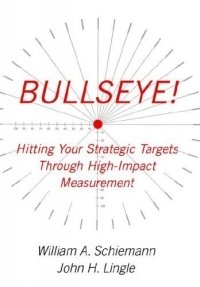Amazon.comAccording to consultants William A. Schiemann and John H. Lingle, companies that truly "manage by measurement" are outperforming those that don"t by an average three-year return on investment of 80 percent versus 45 percent. In Bullseye! Hitting Your Strategic Targets Through High-Impact Measurement, they detail a comprehensive four-phase program for anyone who would like to advance corporate goals by similarly overhauling the way information is gathered, shared, and managed within the organization. Their sweeping system helps leaders accurately and consistently track the performance of a half-dozen key components--customers-competitors, financial stakeholders, employees-subcontractors, technologies, partners-suppliers, and overall communities--and then share resultant data across the board. While business measurement has traditionally been "a monitoring device primarily used to "take the temperature" of the organization and help supervisors know where to focus their attention," Schiemann and Lingle"s approach utilizes it instead to link ideas and behaviors, integrate performance companywide, and increase self-accountability. After demonstrating how corresponding efforts have paid off in Fortune 100 firms such as Procter & Gamble, General Electric, and Sears, they examine deterrents to implementation and explain the process. Recommended for senior executives, managers, and production teams seeking new ways to bolster their bottom lines. --Howard RothmanBook Description
At last,in this book, the great paradox of measurement is resolved. According to the authors" original -- and revealing -- research companies that manage by measurement outperform less disciplined competitors by an average three-year return on investment of 80 percent versus an average ROI of 45 percent. Yet few companies have put in place a disciplined approach for measuring the key nonfinancial, strategic performance areas that are so crucial to a firm"s success.
Bullseye! treats measurement as a key senior-management business issue. The authors explore the role of measurement in adding clarity and specificity to an organization"s strategy, and in driving efforts to translate strategy into operational initiatives and business results.
Organizationalchange and measurement experts William Schiemann and John Lingle have written the first book to provide a complete detailed blueprint for implementing a strategic measurement system. To resolve the measurement paradox, they have created as the centerpiece of Bullseye! a detailed case study that describes a four-phase process that will successfully transform any company into a measurement-managed organization. The four phases of this process are: defining a strategic business model, designing measures to support the model cascading the model and measures throughout the organization, and embedding the measures into the leadership processes of the organization.
In eminently readable prose, the authors confront head-on the powerful forces that conspire to prevent a company from gaining the full value from its measurement system. In the process, Schiemann and Lingle have developed an integrative framework that covers all the major measurement areas: markets and customers, finance, people, operations,the environment, and suppliers. In fact, the authors go Beyond other published accounts of measurement systems by providing strategic tools to manage customer, community, environmental, and regulatory stakeholders along with suppliers, and adaptability -- the level at which a company learns and innovates. Focus and speed, they argue, are the essential competitive qualities. Following the guidelines recommended in this book, executives with responsibility for setting and implementing strategy should be able to make significant improvements in three months and major changes within a year. Bullseye! is must reading for all general managers at the corporate, division, and business-unit levels.
Это и многое другое вы найдете в книге Bullseye! : Hitting Your Strategic Targets Through High-Impact Measurement (William A. Schiemann)
